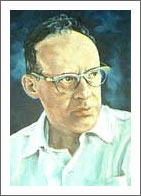
 |
|
History of the Bioacoustics Research Lab
 William J. Fry The Department of Electrical Engineering at the University of Illinois was in the process of developing a strong research program and Lloyd DeVore, who was Bill Fry's professor of theoretical physics at Penn State College, was engaged to establish it. It must be understood that prior to World War II research was not an important undertaking of Electrical Engineering faculty members. Bill Fry was known to DeVore as an unusually clever, independent, and ingenious solver of theoretical physics problems, as they were treated in graduate course work. Bill came to the University of Illinois in late 1946 and immediately endeared himself to many of the old-time, non research oriented, Electrical Engineering faculty members by removing, for trash disposal, their numerous cherished World War I electrical instruments, in order to make room for the only space that could be found for him which was in a tunnel under the then Electrical Engineering Building (later to become the EERL). Frank Fry came at approximately the same time and the two began developing what has come to be known as the Bioacoustics Research Laboratory. Bill Fry wanted to study the central nervous system with sufficient comprehensiveness to begin to understand intimate details of structure and function. The methods employed up to that time had been rather crude, requiring invasion of the brain tissues by physically rigid electrodes and the consequent production of unreasonably large lesions. Such methods were employed with the hope of identifying those structures which might involve particular types of neural activity. Bill had envisioned that ultrasound, which he knew could be focused to very small volumes, would comprise a vastly superior tool by providing for noninvasive alteration of brain tissues. He set out to deal with two related topics: firstly, to develop ultrasonic surgical procedures for affecting the mammalian brain, both reversibly and irreversibly, which would provide for animal experiments and clinical surgical procedures and secondly, to study the detailed neuroanatomy of the mammalian central nervous system, if you will, to determine a complete "circuit diagram" of the neural components. The first of these was accomplished with great success and by the late 1950s had been well demonstrated in animal experiments and was utilized in medical practice in a cooperative program at the University of Iowa. Numerous patients were treated for hyperkinetic and dystonic disorders, including Parkinson's Disease and intractable pain. The procedures, though extremely complex, were successful and Time Magazine discussed these in the December 2, 1957 issue. The project dealing with determination of the "wiring" diagram of the central nervous system also achieved significant success, though because of the enormous complexity of the media being studied and many attending difficulties, only details of small sections of the cat brain were achieved. Nevertheless, the methodology was well demonstrated. Throughout the approximately 20 year period from the mid-40s to the mid-60s, and in order to reach these goals, instruments were invented and developed for generating, detecting, and measuring ultrasound; crucial details regarding how ultrasound propagates in biological media were discovered; the propagation properties important for diagnostic, as well as therapeutic and surgical ultrasound, such as speed of sound, absorption, attenuation, scattering, and impedance, were determined; the physical mechanisms of interaction of ultrasound was studied in some detail and phenomenological theories were developed; toxicity and dosimetry were treated in detail; and nonlinear acoustic properties were begun to be studied. Measuring methods as well as instruments were invented and developed to their full usable potential that are still employed throughout the world. Technicians were trained, graduate students were educated, and approximately 100 papers were published in high level peer-reviewed journals describing all of these scientific and technological developments. Additional research topics were also undertaken. The 1957 meeting of the AIUM was held in Los Angeles, probably in early September, and Bill Fry and Floyd Dunn drove there and returned with Dr. Oka, of Osaka, who spent about a month learning our neurosonic surgery methodologies. During the several day automobile trip back to Illinois, Bill developed the view that it was time to initiate a program to develop an artificial heart. By the time they arrived in Illinois, Bill had worked out a piezoelectric device which, though it seemed promising in the car, turned-out to be very inefficient when detailed calculations were made in the comfort of the Laboratory. Nevertheless, less dramatic, or more conventional, ideas were employed and devices capable of sustaining animals for extensive periods were developed and patented. The ultraconservative attitude of the University of Illinois, at the time, toward the promotion by faculty of their innovations, prompted Bill to organize the Interscience Research Institute to exploit these heart devices and they were no longer treated in the BRL. Further topics that were undertaken in the Laboratory were studies of excitable tissue, with and without ultrasonic stimulation; investigations of the organ of Corti; studies of the modifications of animal behavior produced by neurosonic surgical methods, and others. Thus the Laboratory emerged as pre-eminent and Bill, recognizing the necessity for supporting all those working in this field created what has come to be known as the Allerton Conferences--closed, invited-only participants--held at an estate owned by the University, approximately 25 miles from the campus. Thus the acknowledged world leaders in the field were able to convene and discuss in detail, in isolated, pleasant surroundings, the then important problems of biomedical ultrasound investigation. These have been continued under the direction and supervision of Bill O'Brien and Leon Frizzell. From 1977 to 1995 BRL was directed by Floyd Dunn. Bill O'Brien is the current director. Second and third generation BRL members have become National Academy members, fellows and presidents of numerous professional societies, and continue to lead the ultrasonic bioengineering, biophysics field. |
|||||||||||||||||||||||||||||||||||||||||||||||||||||||||||||||
| Bioacoustics Research Lab. |